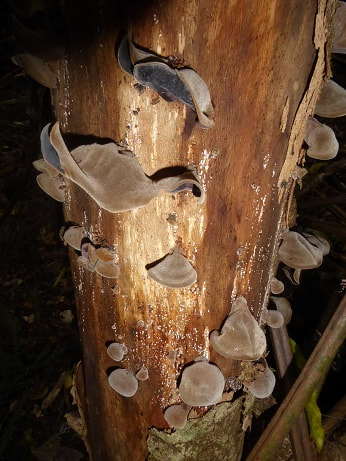
Fruitbodies of both these species lack a medulla when cross-sectioned. heimuer and distinguishable microscopically by its larger basidia and spores, the latter measuring 14.5-18 x 5-6 μm. The European Auricularia auricula-judae is superficially similar, but not so dark as cultivated A. Some strains of "heimuer" cultivated in China have proved to be A. The Asian Auricularia villosula is very similar, but distinguishable microscopically by its shorter hairs (30-70 μm long). When cross-sectioned, a medulla (a central band of parallel hyphae) is normally present. Hairs on the upper surface are 50-150 x 4-6,5 μm. The basidiospores are allantoid (sausage shaped), 11-13 x 4-5 μm. The basidia are cylindrical, 40-65 x 3-6.5 μm, with three transverse septa. The spore-producing underside is smooth to slightly veined, pinkish buff when fresh, purplish grey when dry. The colour of cultivated specimens is often darker.

The upper surface is finely tomentose, fawn to reddish brown when fresh, grey-brown when dry. Description įruitbodies are gelatinous, ear-shaped, and laterally attached to wood. It was given the name Auricularia heimuer based on the Chinese vernacular name for the fungus: heimuer (黑木耳) black wood ear. This research revealed that the most frequently cultivated species was previously misdetermined as Auricularia auricula-judae, a species confined to Europe, and was instead a separate and distinctive species restricted to east Asia. Auricularia heimuer was described in 2014 as a result of molecular research, based on cladistic analysis of DNA sequences, into wild and cultivated species of Auricularia in China.


 0 kommentar(er)
0 kommentar(er)
